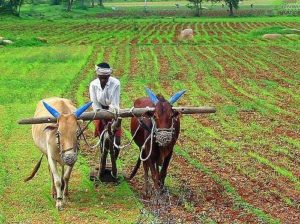Discussing agriculture, procurement, and food security in the context of the 2021-22 Budget, Hussain and Mohapatra contend that reforms affecting millions of farmers can only be achieved by preparing a 10-year roadmap in consultation with the states and other stakeholders.

The Union Budget proposals for FY2021-22 have been welcomed by many commentators. Since the first ‘dream budget’ of former Finance Minister P. Chidambaram for FY1997-98, this is being hailed by some, as a second dream budget. One of the major achievements of the Budget proposals has been to lift the veil on food subsidy and account for it in the revised estimates (RE)1 for FY2020-21 – even if it contributed to a substantial increase in the fiscal deficit to 9.5% of the GDP (gross domestic product). As the ‘Annual Financial Statement’ envisaged under Article 112 of the Constitution of India, the annual Budget of the central government is expected to present a “true and fair view” of the state of public finances. However, for many years, substantial sums of committed expenditure liabilities were being booked outside the Consolidated Fund of India2. Hopefully, this Budget has put an end to this practice. However, as per our projections, it will only be in 2023 that the FCI’s (Food Corporation of India) outstanding dues of food subsidy will be fully paid by the Centre.
Agriculture and food security
For states that are under the purview of the Scheme of Decentralised Procurement (DCP)3, the budget estimates (BE) for procurement4 FY2020-21 are Rs. 0.37 lakh crore, which has now been increased to Rs. 0.78 lakh crore (RE). For FY2021-22, the BE provides Rs 0.40 lakh crore. The amount of pending bills of food subsidy of DCP states is not known but the hope is that these will also be fully paid in FY2021-22.
For FY2020-21, the BE for food subsidy of the FCI was only Rs 0.78 lakh crore, which has been raised to Rs. 3.44 lakh crore (RE). The additional amount of Rs 2.66 lakh crore will enable the FCI to pre-pay the loans taken from National Small Savings Fund (NSSF) since 2016-17. However, the arrears will not be fully wiped off and the FCI will still have an outstanding subsidy of Rs. 1.20 lakh crore by 31 March 2021. Similarly, the NSSF loan outstanding of Rs. 2.55 lakh crore on 31 March 2020 will come down to Rs.1.21 lakh crore by the end of FY2020-21 but it is estimated that even on 31 March 2022, the FCI will have an outstanding loan with the NSSF amounting to Rs 0.71 lakh crore. The estimates of FCI’s subsidy are given in the following table.
Table 1. Estimates of food subsidy of FCI, FY2020-21 and FY2021-22 (Figures in Rs. lakh crore)
| Subsidy arrears | Outstanding loan of NSSF | |
| As on 1 April 2020 | 2.44 | 2.55 |
| Estimate of arrears in FY2020-21 and loan from NSSF | 2.20 | 0.85 |
| Subsidy allocation in FY2020-21 (RE) and repayment of NSSF loan | 3.44* | 2.18* |
| Estimate of outstanding balance on 31 March 2021 | 1.20 | 1.21 |
| Estimate of subsidy to be incurred in FY2021-22 | 1.55 | 0 |
| Subsidy allocation in FY2021-22 (BE) and repayment of NSSF loan | 2.03* | 0.50* |
| Estimated balance on 31 March 2022 | 0.72 | 0.71 |
Understandably, due to farmers’ agitation against the farm laws enacted in September 2020, the central government could not present its vision of future policies on agriculture, water, food procurement and the public distribution system (PDS).
Procurement by the Centre and states
During the last two months, the central government has repeatedly committed to continue its present policy of open-ended procurement6 of wheat and rice. In fact, the central government, in a press release issued on 6 February 2021, has mentioned that 41.1 million tonnes of rice have been procured in the Kharif7 Marketing Season (KMS) 2020-21 (October – September). This is about 18% more than last year.
In KMS 2019-20, 52.0 million tonnes of rice was procured, which is an all-time record. In the last 10 years, several DCP states like Odisha, Chhattisgarh, Andhra Pradesh and Telangana, have substantially increased their procurement. If Uttar Pradesh and Bihar were to procure similar levels of rice, the procurement may well reach 55 million tonnes while the requirement for the PDS and welfare schemes is only about 35 million tonnes.
The 2021-22 Budget gives no indication of how the central government plans to deal with the excess stock of rice that it is likely to have in the central pool, as a result of high procurement in KMS 2020-21. The central government has also been procuring much too much wheat.
This year, Madhya Pradesh procured 12.935 million tonnes of wheat which were 220,000 tonnes more than even Punjab. If wheat procurement in FY2021-22 is as high as the previous year, the central pool stocks of foodgrains on 1 June 2021 can well exceed last year’s record of 100 million tonnes. The buffer norm8 for 1 June 2021 is 41.12 million tonnes.
In 2019-20, a part of the excess stock was used for the Pradhan Mantri Garib Kalyan Yojana9 and about 31.5 million tonnes foodgrains were distributed. Even though the unorganised sector is yet to generate pre-Covid-19 levels of employment, the central government has not given any indication of making additional allocations of food grains. Therefore, the central government will soon have to find a way to deal with the very high level of central pool stocks.
In the Bali Ministerial Conference of the WTO (World Trade Organization) in 2013, an ‘Interim Peace Clause’ was agreed upon, which provided that the members of WTO will not challenge the ‘public stockholding programme [of a country] for food security purposes’. It was also agreed that this provision would remain in place until a permanent solution is agreed. So, the procurement of wheat and rice may not invite objections in the WTO.
However, the central government will find it extremely difficult to release wheat and rice from stocks (procured for food security) for export at subsidised rates due to WTO restrictions. Since the economic cost of rice is Rs. 37,267.60 per tonne (BE 2020-21) and the global market rates are less than US$ 370-380 per tonne, extra rice in central government stocks cannot be exported without subsidy. A similar situation exists for wheat as the international prices of wheat are US$ 260-280 per tonne while the economic cost of government stocks is Rs. 26,838.40 per tonne.
There is apprehension that the central government may resort to selling some rice for the manufacture of ethanol. It will be a travesty of procurement policy if the rice procured (at MSP, in the form of paddy) is ultimately allotted to distilleries for manufacture of ethanol.
Way forward
Despite all the assurances of continued procurement at MSP in the future, the central government will have to bring out a policy to incentivise the cultivation of less water-consuming crops in place of paddy and sugarcane. The farmers’ agitation has made it clear that such deep reforms affecting millions of farmers can be best achieved by preparing a 10-year roadmap in consultation with the states and other stakeholders. It will require incentives to farmers of original green revolution states who will suffer a loss of income from reducing their paddy and sugarcane cultivation. It is not easy but from a long-term perspective, it needs to be done.
By mid-March 2021, the Expert Committee on the three new farm laws appointed by the Supreme Court is expected to submit its report. By then hopefully, the central government will have reached some agreement with the agitating farmers. We believe that only after this, the formulation of medium- and long-term policy for agriculture and food sectors can resume.
It is not possible to address these challenges without extensive consultations with stakeholders. The central government may do well to ask the NITI Aayog to prepare a 10-year plan for policies on agriculture, PDS, and food management. This should also take into account the need for prudent use of groundwater, ecological sustainability of crops, and demand for various food items for the food and nutritional security of vulnerable populations. In the true spirit of federalism, the road map should then be discussed and approved in by the National Development Council.
Notes:
- Budget estimates refers to the amount of money allocated in the budget to any ministry or scheme for the coming financial year. Revised estimates are mid-year review of possible expenditure and need to be authorised for expenditure through parliamentary approval or by re-appropriation order.
- The Consolidated Fund of India is the account of the revenue the Government of India receives – via income tax, customs, central excise, debt and non-debt capital receipts (such as receipts from disinvestment) and the non-tax revenue – and the expenses it makes, including capital expenses, and excluding exceptional items.
- The Scheme of Decentralised procurement (DCP) refers to the procurement of foodgrains to the central government stock, through the agencies of state governments. The states take responsibility for procurement, storage, and distribution. The subsidy incurred by the state governments is directly claimed from the Centre. Any surplus stock, in excess of the PDS requirement of the state, is handed over to FCI which moves it to deficit states. .
- The policy of procurement of foodgrains by the government is the process by which the government undertakes the open-ended procurement of wheat and paddy at minimum support prices. Foodgrains are procured by government agencies for the Central Pool, as per directions issued by the central government, by setting up purchase centres that could be within mandis (markets) or outside it. Food subsidy provided by the central government in the budget meets the difference between the economic cost of foodgrains and their sales realisation at central issue prices for PDS and other welfare schemes.
- The economic cost of food grains procured by the FCI is a total of MSP and bonus (if any) paid to the farmers plus the procurement incidentals and distribution cost.
- Open-ended procurement refers to the process whereby foodgrains are offered by farmers within a stipulated procurement period in accordance with quality specifications of Government of India; these are purchased at MSP by government agencies of the state government and the FCI.
- Kharif crops are crops that are cultivated and harvested in the summer and monsoon season, while rabi crops are cultivated in cool and dry months (winter).
- Foodgrains stocking norms (or buffer norms and strategic reserve) refer to the level of stock in the Central Pool that is sufficient to meet the operational requirement of foodgrains and exigencies at any point of time. It also includes the strategic reserve to stabilise the market for foodgrains.
- Finance Minister Nirmala Sitharaman announced a Rs. 1.70 lakh crore relief package under the Pradhan Mantri Garib Kalyan Yojana to provide relief to the poor during the Covid-19 pandemic.
Courtesy : Siraj Hussain (ICRIER) , Jugal Mohapatra (NABARD Financial Services) .

